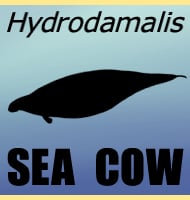In Depth
Although not as large as Megatherium, Glossotherium was one of the largest known ground sloths in North America, though not as large as Eremotherium. Even though Glossoherium is known from across the USA and Mexico however, its full geographical distribution extends into South America all the way down into Argentina. Like other ground sloths, Glossotherium was a heavily built mammal, but one that was likely to have reared up on its hind quarters and pull down branches with its fore arms. Studies of associated coprolites indicate that in life Glossotherium included desert shrubs in its diet, something that helps confirm the idea that the ground sloths were primarily if not exclusively herbivorous.
Exceptionally well preserved specimens of Glossotherium have been recovered from the Rancho La Brea tar pits in California. These individuals suffered the same fate of getting stuck in the tar as other examples of Pleistocene megafauna such as the Columbian mammoth, American mastodon, the short faced bear Arctodus, the sabre toothed cat Smilodon, dire wolves, the American lion and American cheetah as well as three other ground sloths called Megalonyx, Nothrotheriops and Paramylodon amongst many others. The latter ground sloth Paramylodon is thought to be particularly closely related to Glossotherium.
Further Reading
– Eumylodon incertus n. sp. – Anales del Museo Nacional de Historia Natural de Buenos Aires 31:451-456. – L. Kraglievich – 1922. – Les Mammiferes Pleistocenes de la Republique de L�Equateur. – Memoires de la Societe Geologique de France 66:1-391. – R. Hoffstetter – 1952. – Un nuevo Mylodontinae (Edentata, Tardigrada) del Cuaternario del noroeste Argentino (Las Estancias, Catamarca). – Ameghiniana 25(2):115-122. – G. I. Esteban – 1988. – The feeding mechanism in the Pleistocene ground sloth, Glossotherium. – Contributions in Science 415: 1–23. – V. Naples – 1989. – Reassessing the Taxonomy and Affinities of the Mylodontinae Sloths, Glossotherium and Paramylodon (Mammalia: Xenarthra: Tardigrada). – Ph.D. Dissertation, Northern Illinois University. – R. K. McAfee – 2007. – Reassessment of the cranial characters of Glossotherium and Paramylodon (Mammalia: Xenarthra: Mylodontidae). – Zoological Journal of the Linnean Society 155(4):885-903. – R. K. McAfee – 2009. – Cranial and dental studies of Glossotherium robustum (Owen, 1842) (Xenarthra: Pilosa: Mylodontidae) from the Pleistocene of southern Brazil. – Alcheringa: An Australasian Journal of Palaeontology 37: 147–162. – V. Pitana – 2013.










